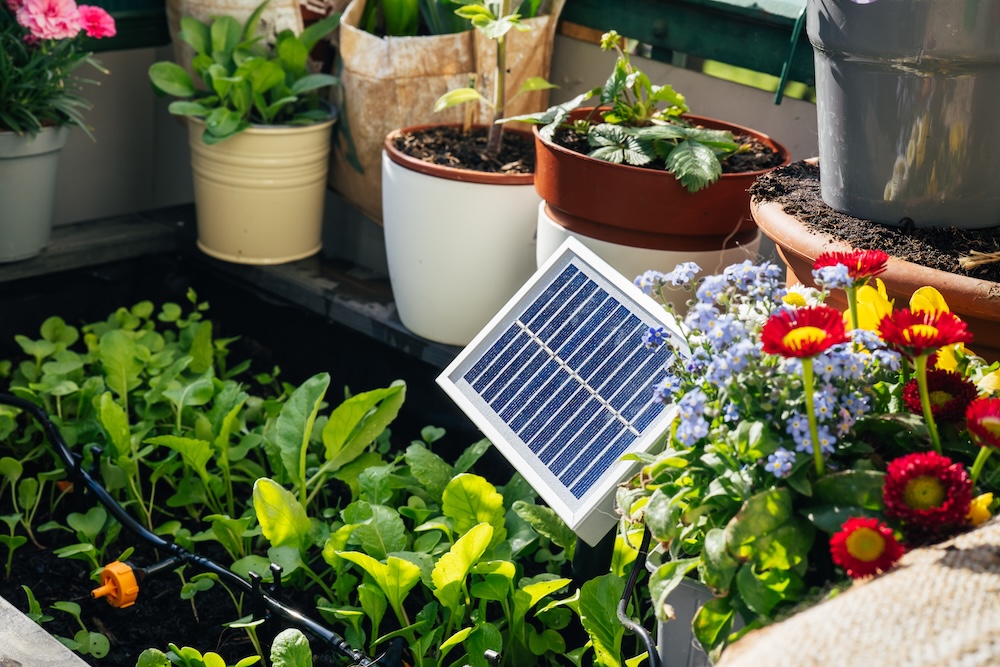Your garden is more than a place to grow food or flowers—it’s an opportunity to live lighter on the earth. With the help of solar power, you can turn your outdoor space into a low-waste, low-cost, energy-smart ecosystem.
This guide explores creative, off-grid ways to bring solar into your garden or yard. From lighting and irrigation to powering tools and sheds, you’ll find smart, sustainable ideas that reduce utility costs and environmental impact—all without complex installations.
Why Go Solar in the Garden?
Outdoor spaces are perfectly suited for solar power. With abundant sun exposure and minimal electrical demands, even small solar panels can go a long way. Benefits include:
- Lower utility bills by reducing energy use
- Energy independence for remote or off-grid areas
- Improved garden health with smart watering and lighting
- No wiring or trenching needed in most cases
- Clean, renewable energy that aligns with sustainable values
And best of all? Most solar garden upgrades are affordable and DIY-friendly.
Solar Lighting for Every Garden Area
Pathway and Border Lights
Solar stake lights are a popular entry point, charging during the day and illuminating paths at night.
Savings: Replaces wired lighting ($20–$50/year)
Lifespan: 2–5 years
Setup: Push into soil and walk away—no cords, timers, or outlets needed
Tip: Choose models with warm LEDs and dusk-to-dawn sensors for a cozy, hands-free glow.
Solar String Lights and Lanterns
Perfect for patios, pergolas, or arbored walkways, these create ambiance without adding to your electric bill.
Savings: Modest, but long-term efficient
Use: Outdoor dining, garden parties, or evening meditation spots
Design Tip: Pair with reclaimed wood or vintage hooks for a rustic look
Many models include clips or hooks for easy recharging during the day.
Motion-Activated Security Lights
Keep your garden safe without wiring into your home’s system.
Savings: Avoids electrician fees and daily electricity use ($30–$75/year)
Bonus: Adds wildlife protection for chickens, compost bins, and more
Best For: Sheds, gates, driveways, and back entries
Solar-Powered Water Features and Irrigation
Solar Fountain Pumps
Add motion to birdbaths, ponds, or planters with low-voltage pumps powered entirely by the sun.
Savings: Replaces electric pumps ($20–$100/year)
Lifespan: 2–4 years
Benefits: Attracts pollinators and reduces mosquito breeding
Look for brushless models for longer life and fewer clogs.
Solar Drip Irrigation Systems
Automate your watering without running power lines or garden hoses across the yard.
Savings: Reduces water waste and grid energy use (up to $200/year)
Ideal for: Raised beds, greenhouses, and food gardens
Smart Add-Ons: Soil moisture sensors or timers for efficient watering
These systems use solar panels to power a small pump from a water tank or rain barrel.
Solar Tools and Off-Grid Workspaces
Charging Tools and Devices with Portable Panels
Use foldable solar chargers or small portable systems to keep your tools ready.
Savings: Offsets battery charging energy (small, but adds up)
Resilience: Keep your gear running even during outages
Use Cases: Trimmers, battery-operated saws, or electric mowers
Look for USB-C compatible chargers or solar generators with outlets.
Solar-Powered Sheds and Greenhouses
Install a mini solar system on your garden shed or greenhouse roof.
Functions:
- Charge devices or tools
- Run LED lighting, fans, or even small heaters
- Power grow lights or humidity sensors
Cost: $500–$2,500 depending on setup
Lifespan: Panels last 20–25 years, batteries 5–10 years
A solar shed setup makes your garden more self-sufficient—and saves money long-term.
Solar Composting and Soil Care
Solar Compost Monitors
Some composting systems include solar-powered thermometers or aerators to optimize decomposition.
Impact: Faster breakdown = richer compost and better soil
Savings: Reduces fertilizer and waste hauling costs
Ideal For: Permaculture gardens, food forests, or urban growers
You can also power compost bin fans with basic solar ventilators to speed the process naturally.
Creative Solar Garden DIYs
- Solar dehydrators: Preserve herbs, fruits, and flowers
- Solar cookers: Try low-and-slow outdoor baking in summer
- Solar bug zappers or deterrents: Keep pests at bay without chemicals
- Solar seed-starting shelves: Use grow lights powered by a panel on your balcony
These small projects promote food security, reduce waste, and keep your garden eco-aligned.
FAQs About Solar Gardening
Do solar garden lights work on cloudy days?
Yes, they store energy in rechargeable batteries and still work in partial sun.
How long do solar garden gadgets last?
Most last 2–5 years; higher-end systems (with quality panels) last 10–25 years.
Can I install solar irrigation myself?
Yes—most systems are plug-and-play and attach easily to barrels or spigots.
Do I need a permit for solar garden panels?
Generally not for small setups. Check your municipality for shed or greenhouse systems.
Is solar gardening worth the investment?
Absolutely. Savings grow over time, and most setups pay for themselves in 1–3 seasons.
Final Thoughts: Let the Sun Tend Your Garden
Solar power in the garden isn’t just practical—it’s poetic. When you light, water, and tend your outdoor space with the sun’s own energy, you close the loop between nature and nurture. Whether you’re installing a few solar lights or powering a full shed, each step is a beautiful investment in a more sustainable, self-sufficient life.









Reader Interactions